As an Amazon Associate I earn from qualifying purchases.
There is nothing quite so wonderful as a piece of perfectly seared fish: Crispy crust on one side, just-barely-done meat in the center. It is one of the great tastes of the world, and it is my go-to method for cooking most any fish. Here’s how to do it perfectly.

I was primarily a seafood cook for 15 years before I ever touched a piece of wild game. Fishing is in my DNA, and I am proud to say my parents taught me well how to catch all sorts of sea creatures. I did not learn this technique from them, however. I learned how to sear a fish when I was a line cook years ago. Pan-searing is a classic restaurant method of cooking fish.
The technique works on any thick fillet or fish steak. I am using striped bass in the process shots below, but most fish will do; grouper is in the photo above.
I’ve made pan seared fish with dozens of species, from salmon and tuna to catfish, snapper, mahi mahi, lingcod and seabass. The only fish that don’t respond well to searing are those with lots of bones, like shad; very small fish, like sardines; or very thin fillets, like sole or small walleye.
Searing fish is not hard to master, but there are some tips and tricks you need to know.
(I seared fish for the TV news in Alabama recently, which shows the technique really well. Here’s that video.)
Skinless or Skin On?
A few things first. Most fish have very tasty skin if it is cooked properly.
Some, like triggerfish or sturgeon or swordfish, have skin so thick or rubbery that it’s essentially leather. Others, like mackerel, have skin so thin you can’t get a decent crisp on it. But ye olde fish, such as bass, perch, salmon, flounder, snapper or rock cod, have excellent skin that crisps nicely. Be sure to scale the fish (or have your fishmonger do it), but leave the skin on the fillet.
I wrote a whole article on which fish have tasty skin, and why, for the most part, it’s a good idea to eat more fish skin here.
But I get it. Some people don’t like fish skin. You can absolutely make seared fish with skinless fish, too. Just sear the side the skin used to be on first. The grouper photo up top is skinless.
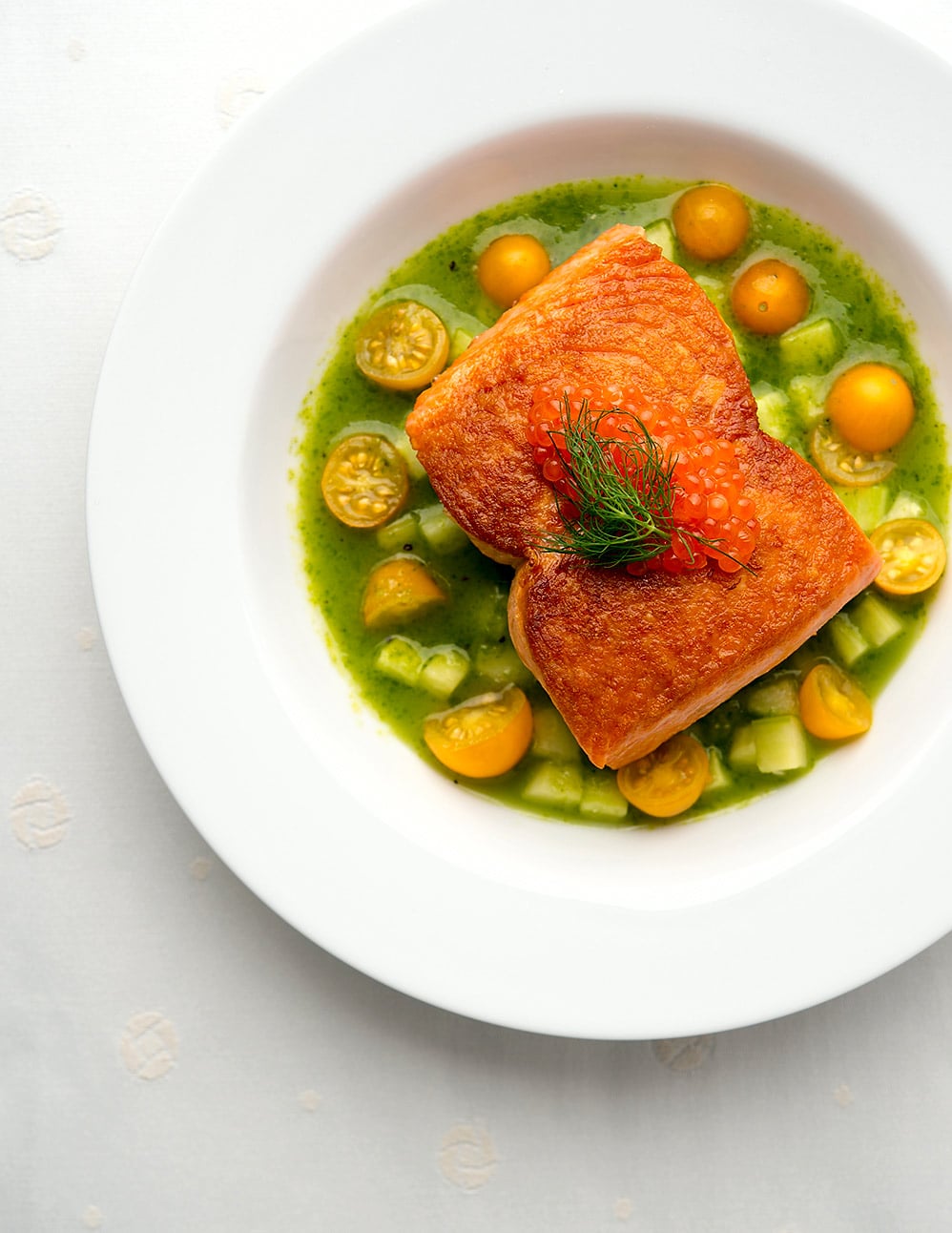
Oil for Seared Fish
I almost always use two sources of oil or fat for seared fish: A very high smoke point oil, or sometimes clarified butter, and then either regular butter or a flavorful finishing oil right at the end.
The reason is because you sear fish at high temperatures, and regular butter will burn and turn bitter. God choices for searing oil include avocado and refined safflower oil, which have smoke points above 500°F. Other options would be canola oil, rice bran oil, refined peanut oil or refined sunflower oil. Clarified butter or beef tallow also work well.
The finishing oil or fat is just for flavor. I almost always just use a knob of butter, but toasted sesame oil is good for a Japanese touch, or a high quality olive oil works for a Mediterranean flair.
Seared Fish Step by Step
Here’s how I sear fish, step by step. Take your fish out 20 minutes before cooking and sprinkle a little salt on both sides. If it is a very thick piece of fish, like swordfish, let it rest at room temperature 30 minutes.
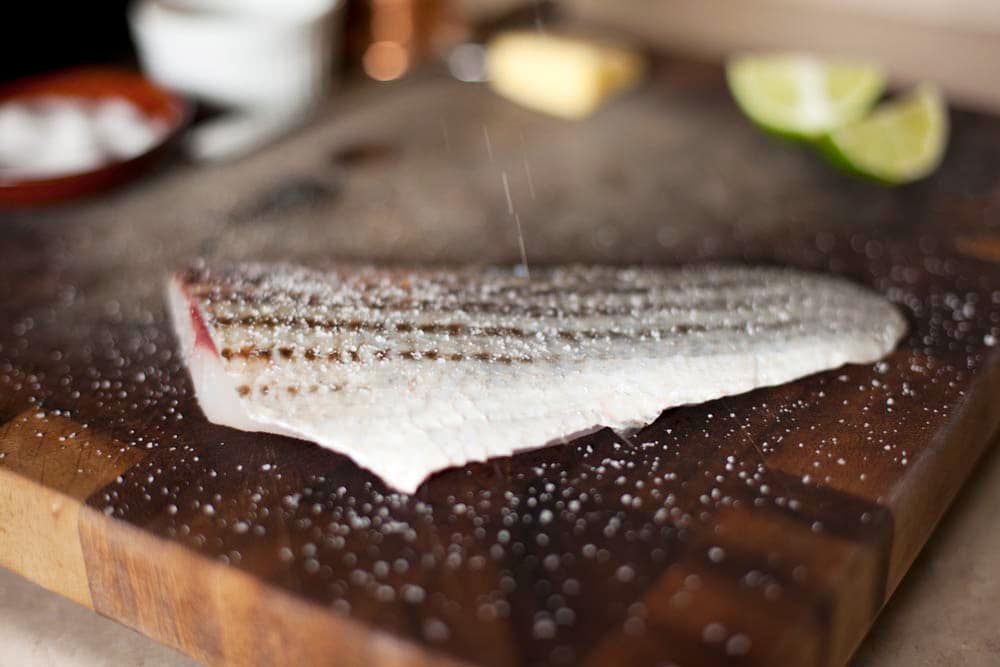
When you are ready to start cooking, set a cast iron or steel pan (don’t use non-stick, because you can’t cook with these pans over high heat) over high heat until it is roaring hot.
While the pan is heating up, take a butter knife and scrape down the skin of the fish fillet to remove any excess moisture. (If there is no skin, skip this part.) Either way, pat the whole fish fillet dry with a paper towel.
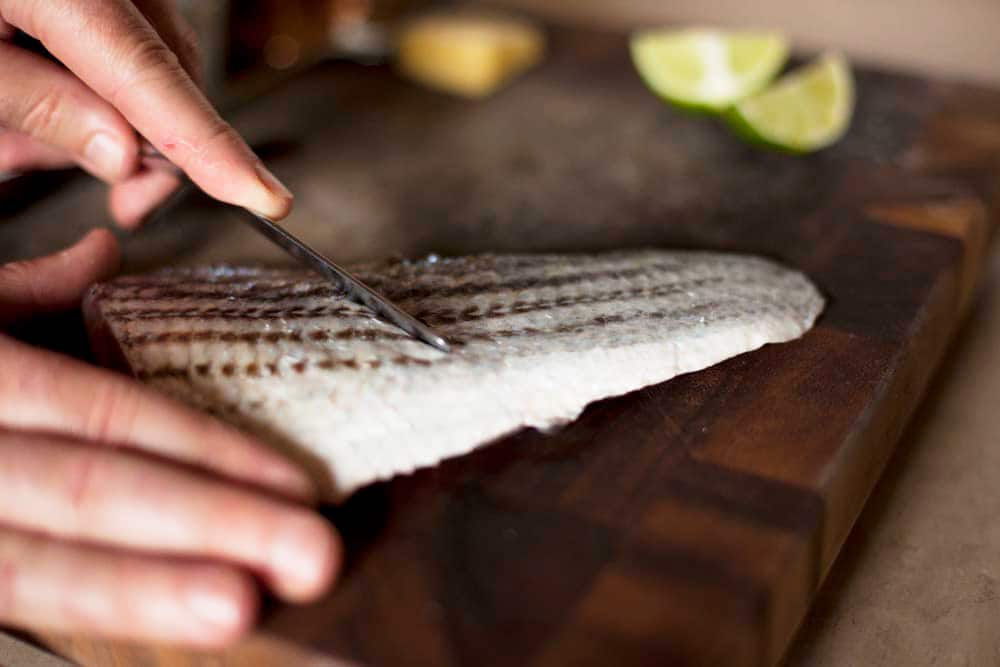
Pour the oil into the center of the hot pan. Swirl to coat the pan and let it get hot. If it starts to smoke, take the pan off the heat until it stops. Place the fish fillets skin side down. If there is no skin on the fish, lay it down on the side the skin used to be on. The moment the fillets hit the pan, jiggle it so the fish doesn’t stick. This is a very important step!
Turn the heat down to medium-high; medium if it is a thick fillet. You want it to sound like sizzling bacon.
Using a bacon press or a metal spatula, press down on each fillet for 30 to 60 seconds. Fish tends to arc when it’s seared like this, and you want the skin side to brown evenly.
Don’t touch the fish. Let it cook undisturbed for at least a minute, possibly as many as 7 to 10 minutes, depending on whether you have a bass fillet or a sturgeon steak. The key here is to let 2/3 of the cooking occur on the skin side. That is what crisps the skin. The thicker the fillet, the longer the cooking time, and the lower the heat.
To Turn or Not to Turn
When to turn your seared fish? Sometimes never. Normal fillets, like on walleye, small striped bass, black seabass, Pacific rockfish — basically any smallish fillet — you can cook through without turning. You cook the exposed side of the fish by constantly spooning the hot oil over it until the meat turns opaque. This trick works very, very well with delicate or smaller fillets.
On thick cuts, like a block of salmon, swordfish, tuna or a really large jack or bass, look at the side of the fish where it meets the pan and you will see the cooked portion climb up the sides; when the fish has a solid ring of browned goodness around the sides, turn.
A good test is to shake the pan — if the fillet moves, you can flip. Use a metal spatula to do this flipping. Be prepared to scrape the skin off the bottom, as if it were stuck. If you have done this properly it will not be stuck entirely, but a few spots might be anyway. This is a critical step.
It is vital that if the fish is really stuck to the pan to let it keep cooking! Be patient. It will release when the sear is perfect. Once you have the fish dislodged, turn it with the help of your free hand stabilizing the fillet on the uncooked side. Gently turn.
How long now? Again, depends on the width of the fish. But remember you did 2/3 of the cooking on the other side, so give it at least a minute for a small bass, 3 to 5 minutes for other fish. In most cases, your pan will be very hot, so you can turn off the heat and let carryover heat finish the job.

Add a tablespoon of butter to the pan and swirl it so it melts quickly. Tip the pan and use a spoon to baste the fish with the butter.
When the fish is done, serve at once: Unlike terrestrial meats, seared fish (other than swordfish and sturgeon) doesn’t like to rest. Oh, and that crispy, yummy skin? It goes on top. You worked hard for it, and you don’t want to ruin that crisp by exposing it to moisture. If you are using a sauce, it goes underneath the fish. Serve with a lemon or lime wedge on the side.
Pan Seared Fish
Ingredients
- 4 fish fillets, about 1 1/2 pounds
- Salt
- 2 tablespoons grapeseed, safflower or peanut oil, or clarified butter
- 1 tablespoon unsalted butter
- Lemon or limes for garnish
Instructions
- Take the fish out of the fridge and salt both sides well. Let them come to room temperature for 20 minutes.
- Near the end of that time, heat a large steel or cast iron sauté pan over high heat. When it's hot, add the oil and swirl it around. Pat the fish dry with paper towels, and if it has skin, use a butter knife to scrape the skin dry; there is often slime on it still.
- Have a metal spatula or a bacon press handy. Set the fish fillets, skin side (or the side where the skin used to be) down, and the instant they hit the pan, jiggle it so they don't stick. Set the bacon press down on the fillets to flatten them, or press down with the spatula. Keep the pressure on for 30 to 60 seconds.
- Baste the exposed side of the fish with the hot oil by tipping the pan a little to collect the oil. Do this until the fish turns opaque, about 30 seconds to 1 minute, if the fish is thick.
- Drop the heat to medium-high -- you want it to sound like bacon sizzling. Let the fish cook undisturbed until it wants to release from the pan, usually about 4 to 6 minutes. Jiggle the pan to see how it's going. With fish thinner than about 1 inch thick, you will not be flipping.
- When the fish has mostly or completely released, use a metal spatula to flip thick fillets, which get cooked another 3 to 5 minutes, or to remove thinner fillets to serve. Set them skin side up and grind some pepper over them.
Notes
Nutrition
Nutrition information is automatically calculated, so should only be used as an approximation.



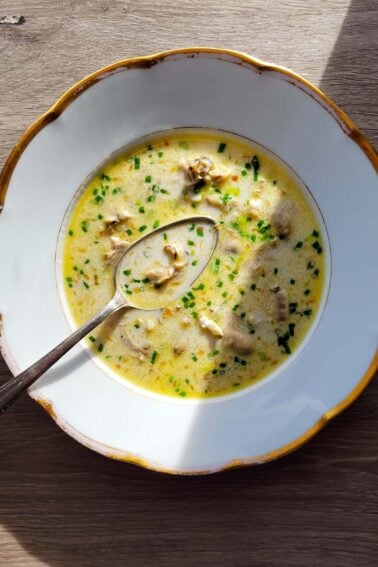


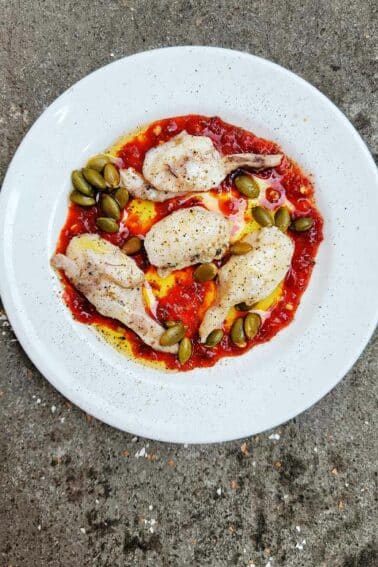
I’ve found that if you apply some oil to the fish with a brush, rather than pouring the oil into the pan, you can avoid the excess oil burning and setting off your smoke alarm.
These are great tips. I wanna try this with the skin on now.
thank you.
Margo: Yep, you can still use this method with skinless fillets. Do most of the cooking where the skin was. Fish steaks are a little different, but you can use this method pretty well. I would not use this method with sole or other very thin fillets. You are exactly right: Too fragile and cooks in a flash.
I just found your website, and this post in particular, after searching how to cook fish as I find it intimidating. I’m looking forward to trying the technique you show in your video. I have a couple of questions:
1. If the piece of fish I want to cook has had the skin removed or if it is a steak, I’m assuming I would still cook it the same way. Correct?
2. My husband is a fan of dover sole. The recipes I have found include dredging in flour and s&p. I haven’t been happy with this method. Could dover sole be cooked your way or is it too fragile as it cooks so quickly.
Thank you for the video. It is extremely helpful.
Hank: whereaway the vid on pan searing fish? Ready to pan sear some redfish fillets. Shot a calm doe btw eyes, quick field work, wiped down with towel soaked in vinegar 25% water 75%, aged 8 days. Just wonderful meat. Chilindron on the way! Shot some woodies in my front yard this morn. A DU friend sent me “the best” duck stew recipe recently. Hell, I can eat 2 stews in a week!
Just tried this tonight and it worked perfectly! Amazing! I even more evenly browned skin than in your photo. Thanks, Hank!
My biggest worry was that the entire filet would just totally stick to the pan at that high heat and that I would end up with a burnt mess (I used a solid aluminum pan that I’ve seasoned myself). So, I really appreciated the little details you gave about how it might stick a little bit, and how you shouldn’t worry about that.
I also used a nice, wide fish spatula, which made flipping the fish without it breaking up a breeze. Very helpful.
Love your blog and hope to get some of your books soon. Keep it up!
After reading this, I know I wasn’t getting crispy skin because I wasn’t drying it well. Very helpful. I’m hoping to catch a small mouth bass or two this weekend so that I can try again for crispy skin.
Very professional great tips.. I’m off to catch some fish!
Thanks,
Great tutorial. Cooked a whole 10″ LM Bass last night using your scraping trick. Fantastic.
Question:
What do you do with the large Striper’s? I’ve always skinned them so you could remove the blood line. I’ve been looking at techniques to bleed them once you beach one, maybe that could remove the need to take out the dark meat?
Thanks!
This is quite helpful! Most of the time I forget to cook on the skin side first, or when I do, I turn it too early. By the way, I sprinkle minced garlic. I like the fish a bit caramelized that blends well with the crispy skin.
Thanks for the basic skills stuff. Now, if I could just find some time to get the flyrod out and head to the creek/pond!
I’ve been making fish for 100 years and I just learned that scraping trick last year. It makes all the difference in the world. Now I have crisp skin but will try your salting trick to see if I can make it even better.
As for aioli, I made cod cake recipe last night that called for a spinach aioli. I didn’t have spinach but did have stinging nettles… wow, what a great sauce. Right up your alley.
That fish picture has my mouth watering!
Mark: I normally keep it pretty simple, with just black pepper and citrus. But a great side sauce would be saffron aioli, which is like a Spanish garlicky mayo.
Good stuff Hank. Rockfish are really fresh and abundant here in the markets in Virginia right now and always a personal favorite seared in the pan! Well done!
Sounds good will try on Okla crappie do you have a good side sauce?
Amy: No, I never have. I’ve never found it necessary, even with fatty salmon — with those fish, I turn the heat down and crisp the skin up slower than with a lean fish.
Do you ever score the skin a few times before searing? I find with very fatty fish like salmon it helps the skin to crisp up and keep from shriveling.
Hank,
Great technique! What a great eating fish a striped bass is.
You mentioned that it won’t work with bony fish like shad (which are running right now in Sacramento). I want to share a video I ran across where a guy shows how to debone a shad – amazing! https://www.youtube.com/watch?v=fTAgJWTTm4I
(I like his method of cleaning striped bass as well)
Mike: Thanks for the tips. I agree that a fish spatula would do a better job. Got to get myself one…
Since you asked for opinions from people that cook for a living ill put my two cents in. First thanks for posting on a basic skill people should know.An emphasis on the skin being dry cannot be said enough.
The first thing I see and a cook is going to look at, is that skin because thats what we used to be scrutinized for. The fish in the photo has uneven browning if just slightly. The spatula you are using in my humble opinion is too big. I think it caused that waviness in that skin.
I use a fish spatula(slotted) or an offset flexible spat. Anyway just little things. keep up the good work, I look forward to all your posts.